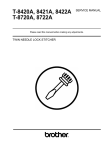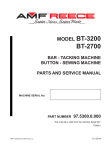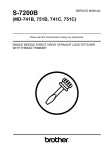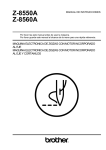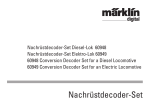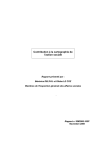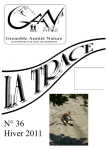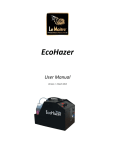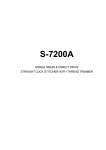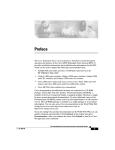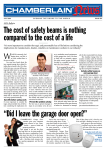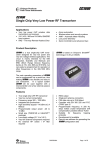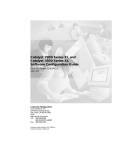Download Brother T-8422A Instruction manual
Transcript
T-8421A TWIN NEEDLE DIRECT DRIVE LOCK STITCHER T-8422A TWIN NEEDLE DIRECT DRIVE LOCK STITCHER WITH THREAD TRIMMER T-8452A TWIN NEEDLE DIRECT DRIVE SPLIT NEEDLE BAR LOCK STITCHER WITH THREAD TRIMMER T-8722A TWIN NEEDLE DIRECT DRIVE LOCK STITCHER WITH LARGE HOOK AND THREAD TRIMMER T-8752A TWIN NEEDLE DIRECT DRIVE SPLIT NEEDLE BAR LOCK STITCHER WITH LARGE HOOK AND THREAD TRIMMER Thank you very much for buying a BROTHER sewing machine. Before using your new machine, please read the safety instructions below and the explanations given in the instruction manual. With industrial sewing machines, it is normal to carry out work while positioned directly in front of moving parts such as the needle and thread take-up, and consequently there is always a danger of injury that can be caused by these parts. Follow the instructions from training personnel and instructors regarding safe and correct operation before operating the machine so that you will know how to use it correctly. SAFETY INSTRUCTIONS 1. Safety indications and their meanings This instruction manual and the indications and symbols that are used on the machine itself are provided in order to ensure safe operation of this machine and to prevent accidents and injury to yourself or other people. Indications DANGER The instructions which follow this term indicate situations where failure to follow the instructions may result in death or serious injury. CAUTION The instructions which follow this term indicate situations where failure to follow the instructions could cause injury when using the machine or physical damage to equipment and surroundings. Symbols ····· This symbol ( ) indicates something that you should be careful of. The picture inside the triangle indicates the nature of the caution that must be taken. (For example, the symbol at left means “beware of injury”.) ····· This symbol ( ····· This symbol ( ) indicates something that you must do. The picture inside the circle indicates the nature of the thing that must be done. (For example, the symbol at left means “you must make the ground connection”.) ) indicates something that you must not do. T-8421A, 8422A, 8452A, 8722A, 8752A i 2. Notes on safety DANGER Wait at least 5 minutes after turning off the power switch and disconnecting the power cord from the wall outlet before opening the face plate of the control box. Touching areas where high voltages are present can result in severe injury. CAUTION Environmental requirements Use the sewing machine in an area which is free from sources of strong electrical noise such as electrical line noise or static electric noise. Sources of strong electrical noise may cause problems with correct operation. Any fluctuations in the power supply voltage should be within ±10% of the rated voltage for the machine. Voltage fluctuations which are greater than this may cause problems with correct operation. The power supply capacity should be greater than the requirements for the sewing machine's power consumption. Insufficient power supply capacity may cause problems with correct operation. The ambient temperature should be within the range of 5°C to 35°C during use. Temperatures which are lower or higher than this may cause problems with correct operation. The relative humidity should be within the range of 45% to 85% during use, and no dew formation should occur in any devices. Excessively dry or humid environments and dew formation may cause problems with correct operation. In the event of an electrical storm, turn off the power and disconnect the power cord from the wall outlet. Lightning may cause problems with correct operation. Installation Machine installation should only be carried out by a qualified technician. Contact your Brother dealer or a qualified electrician for any electrical work that may need to be done. The sewing machine weighs approximately 50 kg. The installation should be carried out by two or more people. Do not connent the power cord until installation is complete. The machine may operate if the treadle is depressed by mistake, which could result in injury. Turn off the power switch before inserting or removing the plug, otherwise damage to the control box could result. Be sure to connect the ground. If the ground connection is not secure, you run a high risk of receiving a serious electric shock, and problems with correct operation may also occur. ii When securing the cords, do not bend the cords excessively or fasten them too hard with staples, otherwise there is the danger that fire or electric shocks could occur. If using a work table which has casters, the casters should be secured in such a way so that they cannot move. Use both hands to hold the machine head when tilting it back or returning it to its original position. If only one hand is used, the weight of the machine head may cause your hand to slip, and your hand may get caught. Be sure to wear protective goggles and gloves when handling the lubricating oil and grease, so that they do not get into your eyes or onto your skin, otherwise inflammation can result. Furthermore, do not drink the oil or eat the grease under any circumstances, as they can cause vomiting and diarrhea. Keep the oil out of the reach of children. T-8421A, 8422A, 8452A, 8722A, 8752A CAUTION Sewing This sewing machine should only be used by operators who have received the necessary training in safe use beforehand. Attach all safety devices before using the sewing machine. If the machine is used without these devices attached, injury may result. The sewing machine should not be used for any applications other than sewing. Do not touch any of the moving parts or press any objects against the machine while sewing, as this may result in personal injury or damage to the machine. Be sure to wear protective goggles when using the machine. If goggles are not worn, there is the danger that if a needle breaks, parts of the broken needle may enter your eyes and injury may result. Turn off the power switch at the following times. The machine may operate if the treadle is depressed by mistake, which could result in injury. When threading the needle When replacing the bobbin and needle When not using the machine and when leaving the machine unattended If using a work table which has casters, the casters should be secured in such a way so that they cannot move. Use both hands to hold the machine head when tilting it back or returning it to its original position. If only one hand is used, the weight of the machine head may cause your hand to slip, and your hand may get caught. If an error occurs in machine, or if abnormal noises or smells are noticed, immediately turn off the power switch. Then contact your nearest Brother dealer or a qualified technician. If the machine develops a problem, contact your nearest Brother dealer or a qualified technician. Cleaning Turn off the power switch before carrying out cleaning. The machine may operate if the treadle is depressed by mistake, which could result in injury. Use both hands to hold the machine head when tilting it back or returning it to its original position. If only one hand is used, the weight of the machine head may cause your hand to slip, and your hand may get caught. Be sure to wear protective goggles and gloves when handling the lubricating oil and grease, so that they do not get into your eyes or onto your skin, otherwise inflammation can result. Furthermore, do not drink the oil or eat the grease under any circumstances, as they can cause vomiting and diarrhea. Keep the oil out of the reach of children. Use only the proper replacement parts as specified by Brother. T-8421A, 8422A, 8452A, 8722A, 8752A iii 3.Warning labels The following warning labels appear on the sewing machine. Please follow the instructions on the labels at all times when using the machine. If the labels have been removed or are difficult to read, please contact your nearest Brother dealer. 1 2 3 Be sure to connect the ground. If the ground connection is not secure, you run a high risk of receiving a serious electric shock, and problems with correct operation may also occur. 4 Direction of operation Safety devices: (A) Finger guard (B) Thread take-up cover Oil pan 2867M Control box 2083M 2868M iv T-8421A, 8422A, 8452A, 8722A, 8752A CONTENTS 1. MACHINE SPECIFICATIONS .............. 1 7. SEWING ............................................... 32 2. NAMES OF MAJOR PARTS................ 3 7-1. Sewing............................................................32 7-2. Backtacking ....................................................33 7-3. Sewing condensed stitches ............................34 3. INSTALLATION.................................... 4 3-1. Table processing diagram .............................. 5 3-2. Installation ...................................................... 5 3-3. Lubrication...................................................... 9 3-4. Connecting the cords ..................................... 11 3-4-1. Opening the control box cover ............ 11 3-4-2. Connecting the cords .......................... 11 3-5. Test operation (Operating the treadle) ........... 15 4. PREPARATION BEFORE SEWING .... 16 4-1. Installing the needle .......................................... 16 4-2. Removing the bobbin ..................................... 17 4-3. Winding the lower thread ............................... 18 4-4. Installing the bobbin ....................................... 19 4-5. Threading the upper thread............................ 21 4-6. Adjusting the stitch length .............................. 23 4-7. Using the knee lifter ....................................... 23 4-8. Using the thread wiper (Models with thread trimmer only) .................. 23 4-9. Corner sewing method (T-8452A, 8752A)...... 24 5. USING THE OPERATION PANEL (BASIC OPERATIONS)........................ 25 8. THREAD TENSION .............................. 35 8-1. Adjusting the thread tension ...........................35 8-2. Adjusting the presser foot pressure ................36 8-3. Adjusting the trailing length after thread trimming (Models with thread trimmer only)....36 8-4. Adjusting the thread take-up amount..............37 9. CLEANING ........................................... 38 9-1. Daily cleaning procedures ..............................38 9-2. Lubricating via the oil cover (every 6 months).............................................39 9-3. Applying grease – When “GREASEUP” appears (Semi dry specifications)...................40 10. ADJUSTING THE ROTARY HOOK LUBRICATION AMOUNT .................. 43 11. TROUBLESHOOTING ....................... 44 11-1. Sewing..........................................................44 11-2. Error code displays .......................................49 5-1. Names and functions ..................................... 25 5-2. Sewing start and end backtack stitches ......... 27 5-3. Sewing fixed stitches...................................... 28 5-4. Using the lower thread counter ...................... 29 6. USING THE OPERATION PANEL (ADVANCED OPERATIONS) .............. 30 6-1. Names and functions ..................................... 30 6-2. Adjusting the needle up stop position............. 31 6-3. LOCK key....................................................... 31 6-4. Resetting all settings to their defaults ............ 31 T-8421A, 8422A, 8452A, 8722A, 8752A 1. MACHINE SPECIFICATIONS 1. MACHINE SPECIFICATIONS A A B C D E B C D E F Rotary hook 4 Standard hook 7 Large hook Stitch function 2 Fixed needle bar 5 Split needle bar Thread trimmer 1 - 2 ○ Quick reverse Thread wiper 4 ○ ○ T ○ - Lubrication type 0 Minimum lubrication 3 Semi dry F F 1 Use For foundation 3 For light-weight and medium- weight materials T-8421A, 8422A, 8452A, 8722A, 8752A 5 For heavy-weight materials 1. MACHINE SPECIFICATIONS T-8421A Max. sewing speed Start backtacking and continuous backtacking speed End backtacking speed Max. stitch length Presser foot Lifting lever height Knee lifter Feed dog height Needle (DP×5) Motor Control circuit -T3F 3,000 rpm -T33 3,000 rpm -T03 4,000 rpm -T05 3,000 rpm 250–1,800 rpm 1,000 rpm 4 mm 5 mm 7 mm 13 mm 1 mm #11–#16 AC servo motor (4-pole, 550W) Microprocessor #9–#14 #14–#22 T-8422A Max. sewing speed Start backtacking and continuous backtacking speed End backtacking speed Max. stitch length Presser foot Lifting lever height Knee lifter Feed dog height Needle (DP×5) Motor Control circuit -403 4,000 rpm -433 -405 3,000 rpm 250–1,800 rpm 1,000 rpm 4 mm 5 mm 7 mm 13 mm 1 mm #11–#16 AC servo motor (4-pole, 550W) Microprocessor #14–#22 T-8452A -403 Max. sewing speed Start backtacking and continuous backtacking speed End backtacking speed Max. stitch length Presser foot Lifting lever height Knee lifter Feed dog height Needle (DP×5) Motor Control circuit -405 3,000 rpm 250–1,800 rpm 1,000 rpm 5 mm 7 mm 13 mm 1 mm #11–#16 #14–#22 AC servo motor (4-pole, 550W) Microprocessor T-8722A, 8752A -403 Max. sewing speed Start backtacking and continuous backtacking speed End backtacking speed Max. stitch length Presser foot Lifting lever height Knee lifter Feed dog height Needle (DP×5) Motor Control circuit -405 3,000 rpm 250–1,800 rpm 1,000 rpm 7 mm 7 mm 13 mm 1 mm #11–#16 #14–#22 AC servo motor (4-pole, 550W) Microprocessor T-8421A, 8422A, 8452A, 8722A, 8752A 2 2. NAMES OF MAJOR PARTS 2. NAMES OF MAJOR PARTS The settings for this sewing machine are carried out using the operation panel (13), and so this panel is not used. (Settings made using this panel will not affect sewing machine operation.) 2869M (1) (3) (5) (7) (9) (11) (13) (15) Bobbin winder Lifting lever Presser foot Knee lifter assembly Stitch length dial Oil gauge window Operation panel Stop lever (T-8452A, 8752A ) Safety devices (16) Thread take-up cover 3 (2) (4) (6) (8) (10) (12) (14) Thread wiper (T-8422A, 8452A, 8722A, 8752A) Quick reverse (Actuator) Control box Power switch Reverse lever Machine pulley Cotton stand (17) Finger guard T-8421A, 8422A, 8452A, 8722A, 8752A 3. INSTALLATION 3. INSTALLATION CAUTION Machine installation should only be carried out by a qualified technician. Contact your Brother dealer or a qualified electrician for any electrical work that may need to be done. The sewing machine weighs approximately 50 kg. The installation should be carried out by two or more people. Do not connect the power cord until installation is complete. The machine may operate if the treadle is depressed by mistake, which could result in injury. Use both hands to hold the machine head when tilting it back or returning it to its original position. If only one hand is used, the weight of the machine head may cause your hand to slip, and your hand may get caught. About the machine set-up location Do not set up this sewing machine near other equipment such as televisions, radios or cordless telephones, otherwise such equipment may be affected by electronic interference from the sewing machine. The sewing machine should be plugged directly into an AC wall outlet. Operation problems may result if extension cords are used. 2086M Carrying the machine The machine should be carried by the arm by two people as shown in the illustration. * Hold the motor cover (A) by hand also so that the pulley does not rotate. 2870M Tilting back the machine head Hold section (B) with your foot so that the table does not move, and then push the arm with both hands to tilt back the machine head. 2871M Returning the machine head to the upright position 1. Clear away any tools, etc. which may be near the table holes. 2. While holding the face plate with your left hand, gently return the machine head to the upright position with your right hand. 2872M T-8421A, 8422A, 8452A, 8722A, 8752A 4 3. INSTALLATION 3-1. Table processing diagram The top of the table should be 40 mm in thickness and should be strong enough to hold the weight and with-stand the vibration of the sewing machine. Drill holes as indicated in the illustration below. Cotton stand hole Cord hole Head rest hole Control box mounting hole 2873M 3-2. Installation 1. Control box (1) (2) (3) (4) (5) Control box Bolts [3 pcs] Nuts [3 pcs] Spring washers [3 pcs] Washers [3 pcs] 2. Connecting rod (6) Connecting rod (7) Nut 2091M 5 T-8421A, 8422A, 8452A, 8722A, 8752A 3. INSTALLATION 3. Power switch (1) Power switch (2) Screws [2 pcs] Operator 2092M 4. Oil pan (1) (2) (3) (4) Head cushions (left) [2 pcs] Head cushions (right) [2 pcs] Oil pan Oiler 2874M 5. Rubber cushions (1) Rubber cushions [2 pcs] (2) Nails [4 pcs] 6. Knee lifter complying bar (3) Knee lifter complying bar 2875M T-8421A, 8422A, 8452A, 8722A, 8752A 6 3. INSTALLATION 7. Machine head (1) Hinges [2 pcs] (2) Machine head (3) Head rest NOTE: Tap the head rest (3) securely into the table hole. If the head rest (3) is not pushed in as far as it will go, the machine head will not be sufficiently stable when it is tilted back. 2876M 8. Operation panel (1) Operation panel (2) Screws [2 pcs] (Use for tightening rear cover) 2877M 9. Cotton stand (1) Cotton stand NOTE: Securely tighten the nut (4) so that the two rubber cushions (2) and the washer (3) are securely clamped and so that the cotton stand (1) does not move. 2878M 7 T-8421A, 8422A, 8452A, 8722A, 8752A 3. INSTALLATION 10. Knee lifter plate (1) Knee lifter plate (2) Bolt * Loosen the bolt (3) and the bolt (4), and move the knee lifter plate (1) to a position where it is easy to use. 2879M <Knee lifter adjustment> 1. Turn the machine pulley so that the feed dog is below the top of the needle plate. 2. Lower the presser foot (5) by using the lifting lever (4). 2880M 2881M 3. Loosen the nut (6). 4. Turn the screw (8) to adjust so that the amount of play in the knee lifter (7) is approximately 2 mm when the knee lifter plate (1) is gently pressed. 5. Securely tighten the nut (6). 6. Loosen the nut (9). 7. Turn the screw (10) until the distance between the end of the screw (10) and the knee lifter (7) is approximately 5 mm. 8. Turn the adjusting screw (10) to adjust so that the presser foot (5) is at the desired position within a distance of 13 mm of the needle plate when the knee liter plate (1) is fully pressed. 9. After adjustment is completed, securely tighten the nut (9). Within 13 mm 2882M T-8421A, 8422A, 8452A, 8722A, 8752A 8 3. INSTALLATION 3-3. Lubrication CAUTION Do not connect the power cord until lubrication has been completed, otherwise the machine may operate if the treadle is depressed by mistake, which could result in injury. Be sure to wear protective goggles and gloves when handling the lubricating oil and grease, so that they do not get into your eyes or onto your skin, otherwise inflammation can result. Furthermore, do not drink the oil or eat the grease under any circumstances, as they can cause vomiting and diarrhea. Keep the oil out of the reach of children. The sewing machine should always be lubricated and the oil supply replenished before it is used for the first time, and also after long periods of non-use. Use only the lubricating oil (Nisseki Mitsubishi Sewing Lube 10N; VG10) specified by Brother. * If this type of lubricating oil is difficult to obtain, the recommended oil to use is <Exxon Mobil Essotex SM10; VG10>. <Lubricating via the oil cover> 1. Tilt back the machine head. 2. Remove the rubber cap (1). 3. Use the accessory oiler (2) to pour lubricating oil into the oil cover (3) until the oil level reaches the reference line (4). NOTE: Do not fill with lubricating oil past the reference line (4). If you pour in too much lubricating oil, it may spill out when the machine head is tilted back. 4. Replace the rubber cap (1). 5. Return the machine head to its original position. * If the lubricating oil level drops below the bottom (6) of the oil gauge window (5), be sure to add more oil. 2883M <Lubricating via the oil tank> 1. Remove the rubber cap (1). 2. Use the accessory oiler (2) to pour in lubricating oil until the oil level reaches the top reference line (4) of the oil gauge window (3). 3. Replace the rubber cap (1). * If the lubricating oil level drops below the bottom reference line (6), be sure to add more oil. 2884M 9 T-8421A, 8422A, 8452A, 8722A, 8752A 3. INSTALLATION ■Lubrication Apply 1 - 2 drops of oil to the places indicated by the arrows. <Minimum lubrication type only> * Do not apply oil for semi dry types. 2885M <T-8452A, 8752A> <Semi dry type and minimum lubrication type> Rotary hook race (left and right) 2886M 2887M T-8421A, 8422A, 8452A, 8722A, 8752A 10 3. INSTALLATION 3-4. Connecting the cords DANGER Wait at least 5 minutes after turning off the power switch and disconnecting the power cord from the wall outlet before opening the face plate of the control box. Touching areas where high voltages are present can result in severe injury. CAUTION Contact your Brother dealer or a qualified electrician for any electrical work that may need to be done. Do not connect the power cord until all cords have been connected. The machine may operate if the treadle is depressed by mistake, which could result in injury. Be sure to connect the ground. If the ground connection is not secure, you run a high risk of receiving a serious electric shock, and problems with correct operation may also occur. 3-4-1. Opening the control box cover (1) Screw (2) Cover 2888M 3-4-2. Connecting the cords 1. Sewing machine cords 2889M 11 T-8421A, 8422A, 8452A, 8722A, 8752A 3. INSTALLATION (1) (2) (3) (4) 7-pin head detector unit connector 10-pin operating panel connector 14-pin encoder connector 14-pin machine connector Refer to the following page for the 4-pin motor connector. Push in securely until the tabs (5) engage. 3131M 3132M 2. Repeat cable tie (1) Repeat cable tie (2) Wire clip <Removal> NOTE: Bind the cords in such a way that the connector does not get pulled out. All cords that come out from the control box should be secured to the cord holder (3) using the repeat cable tie (1), otherwise vibration from the sewing machine may cause the cords to become disconnected, which can cause problems with the operation of the control box. Press the tab. <Securing> Cords <Closing the cover> 2110M T-8421A, 8422A, 8452A, 8722A, 8752A 12 3. INSTALLATION 2890M 3. Other cords (1) (2) (3) (4) 6-pin power supply connector 4-pin motor connector Wire clip Power cord <For single-phase specifications> Insert the power cord plug (5) into a wall outlet. <For three-phase specifications> 1. Attach an appropriate plug to the power cord (4). (The green and yellow wire is the ground wire.) 2. Insert the plug into a properly-grounded AC power supply. <Single-phase> <Three-phase> NOTE: Do not use extension cords, otherwise machine operation problems may result. Green and yellow wire (ground wire) 2891M 13 T-8421A, 8422A, 8452A, 8722A, 8752A 3. INSTALLATION 4. Ground wire (1) Ground wire (2) Screw [With washer] (3) Screw Ground symbol NOTE: Always be sure to connect the ground wire (1), otherwise problems may occur with sewing machine operation. Oil pan 2892M T-8421A, 8422A, 8452A, 8722A, 8752A 14 3. INSTALLATION 3-5. Test operation (Operating the treadle) CAUTION Do not touch any of the moving parts or press any objects against the machine while sewing, as this may result in personal injury or damage to the machine. 2114M <Turning on the power> Press the ON power switch (1). The power indicator (2) and (3) will illuminate. NOTE: When turning the power switch on for the first time The treadle and the operation panel will not operate for approximately four seconds after the power switch is turned on. After approximately 4 seconds, “iniT rPM” (speed initialization) or “iniT ALL” (full initialization) will be displayed on the operation panel. After “iniT rPM” or “iniT ALL” is displayed, the treadle can be operated. (The operation panel will change to the stitch number display.) This message will not appear the second and subsequent times that the power switch is turned on. 2893M 2116M <Test operation> 1. Check that the machine sews at low speed when the treadle (4) is gently pressed to position (B). 2. Then check that it sews at high speed when the treadle (4) is gently pressed to position (C). 3. After pressing the treadle (4) forward, check that the needle is lowered to the top of the needle plate when the treadle (4) is returned to the neutral position (A). (when needle down stopping has been set.) 4. If the treadle (4) is pressed to position (D), (thread trimming is carried out for models with thread trimmer) and the needle rises above the needle plate and stops. 2117M 15 T-8421A, 8422A, 8452A, 8722A, 8752A 4. PREPARATION BEFORE SEWING 4. PREPARATION BEFORE SEWING 4-1. Installing the needle CAUTION Turn off the power switch before installing the needle. The machine may operate if the treadle is depressed by mistake, which could result in injury. 1. Turn the machine pulley to move the needle bar to its highest position. 2. Loosen the screws (1). 3. Insert the needle (2) straight in as far as it will go so that the long groove is facing inward, and then securely tighten the screws (1). <T-8421A, 8422A, 8722A> Long groove 2894M <T-8452A, 8752A> Long groove 3125M T-8421A, 8422A, 8452A, 8722A, 8752A 16 4. PREPARATION BEFORE SEWING 4-2. Removing the bobbin CAUTION Turn off the power switch before removing the bobbin. The machine may operate if the treadle is depressed by mistake, which could result in injury. <Latch type> 1. Open the slide plates (1) by moving them to the right and left. 2. Pull the rotary hook latches (2) upward, and them remove the bobbins (3). 2895M <Bobbin case type> 1. Open the slide plates (1) by moving them to the right and left. 2. Lift up the latch (2) of the rotary hook, and then remove the bobbin case (3). 3. Remove the bobbin. 2896M 17 T-8421A, 8422A, 8452A, 8722A, 8752A 4. PREPARATION BEFORE SEWING 4-3. Winding the lower thread CAUTION Do not touch any of the moving parts or press any objects against the machine while winding the lower thread, as this may result in personal injury or damage to the machine. 1. Turn on the power switch. 2. Place the bobbin (1) onto the bobbin winder shaft (2). 3. Wind the thread several times around the bobbin (1) in the direction indicated by the arrow. * Check that the thread is not loose anywhere along the thread path. 4. Push the bobbin presser arm (3) toward the bobbin (1). 5. Raise the presser foot with the lifting lever. 6. Depress the treadle. Lower thread winding will then start. 7. Once winding of the lower thread is completed, the bobbin presser arm (3) will return automatically. 8. After the thread has been wound on, remove the bobbin and cut the thread with the knife (4). 2897M * Loosen the screw (5) and move the bobbin presser (6) to adjust the amount of thread wound onto the bobbin. NOTE: The amount of thread wound onto the bobbin should be a maximum of 80 % of the bobbin capacity. More thread Less thread 2123M 2124M T-8421A, 8422A, 8452A, 8722A, 8752A 18 4. PREPARATION BEFORE SEWING 4-4. Installing the bobbin CAUTION Turn off the power switch before installing the bobbin. The machine may operate if the treadle is depressed by mistake, which could result in injury. 2898M <Latch type> 1. Insert the bobbin (1) into the rotary hook (2) so that the winding direction is as shown in the illustration. 2. Return the rotary hook latch (3) to its original position. 3. Turn the machine pulley to rotate the rotary hook (2) until the tension spring (4) is visible. 4. Pass the thread through slit (5) in the rotary hook and then pass it under the thread tension spring. 5. Pull out the thread to a length of approximately 50 mm. 6. Close the slide plates. 2899M 2900M There is an anti-spin spring (6) inside the rotary hook. The anti-spin spring (6) prevents the bobbin from racing at times such as during thread trimming. Use bobbins (1) made of light alloy as specified by BROTHER. 2901M 19 T-8421A, 8422A, 8452A, 8722A, 8752A 4. PREPARATION BEFORE SEWING <Bobbin case type> 1. Insert the bobbin (1) into the bobbin case (2) so that the winding direction is as shown in the illustration. 2. There are three types of cap (2) (<A>, <B> and <C>). Thread the thread by one of the following methods in accordance with the shape of the bobbin case (2) being used. <A> <A> 1) 2) 2902M Pass the thread through slot (3) and under the thread tension spring (4). Pass the thread through the thread hole (8) and pull out about 50 mm. <B> <C> 1) Pass the thread through slot (3) and under the thread tension spring (4). 2) Pass the thread through slots (5) and (6), and then through the spring (7). 3) Pass the thread through the thread hole (8) and pull out about 50 mm. <B> 3. Insert the bobbin case (2) into the rotary hook. 4. Push latch (9) of the rotary hook flat. 5. Close the slide plates. 3126M 3127M <C> 2903M There is an anti-spin spring (10) inside the rotary hook. The anti-spin spring (10) prevents the bobbin from racing at times such as during thread trimming. Use bobbins (1) made of light alloy as specified by BROTHER. 2904M T-8421A, 8422A, 8452A, 8722A, 8752A 20 4. PREPARATION BEFORE SEWING 4-5. Threading the upper thread CAUTION Turn off the power switch before threading the upper thread. The machine may operate if the treadle is depressed by mistake, which could result in injury. ・ Turn the machine pulley and raise the thread take-up (1) before threading the upper thread. This will make threading easier and it will prevent the thread from coming out at the sewing start. ・ Thread the left-side thread first. 21 T-8421A, 8422A, 8452A, 8722A, 8752A 4. PREPARATION BEFORE SEWING <For all models except foundation specifications and T-8452A-405> Do not pass the thread through. <For foundation specifications Center and T-8452A-405> Pass the thread through. (Refer to p.37) If the tension discs are opened as follows, the thread will become easier to thread. <Models with thread trimmer> Press the tension release plate (2). <Models without thread trimmer> Press the tension release plate (2), or operate the lifting lever or the knee lifter to raise the presser foot. The thread can be passed securely in between the tension discs. Pass the thread on the inside of the tab (3). 2905M T-8421A, 8422A, 8452A, 8722A, 8752A 22 4. PREPARATION BEFORE SEWING 4-6. Adjusting the stitch length 1. Unlock the stitch length dial (2) by turning the dial lock lever (1) to the right until a click is heard. 2. Turn the stitch length dial (2) clockwise or counterclockwise so that the desired stitch length is at the uppermost position on the dial. The larger the number, the longer the stitch length will be. (The numbers on the dial are for use as a guide. The length of the finished stitches may vary depending on the type and thickness of material being sewn. Adjust while looking at the finished stitches.) When turning the stitch length dial (2) from a larger setting to a smaller setting, it will be easier to turn the dial if the reverse lever (3) is pushed to the halfwaydown position. 3. Turn the dial lock lever (1) firmly to the left to lock the stitch length dial (2). * Check that the stitch length dial (2) does not rotate. Locked Unlocked 2906M 4-7. Using the knee lifter The presser foot (2) can be raised by pressing the knee lifter plate (1). 2907M 2908M 4-8. Using the thread wiper (Models with thread trimmer only) 2909M Press the thread wiper switch (1) to the side. After thread trimming is carried out, the thread wiper (2) will pull up the thread. 2209M 2910M 23 T-8421A, 8422A, 8452A, 8722A, 8752A 4. PREPARATION BEFORE SEWING 4-9. Corner sewing method (T-8452A, 8752A) NOTE: If using this machine in place of a single-needle machine, remove the needle which is not being used. In such cases, do not use the procedures given below to stop the unused needle bar from moving, otherwise damage to the machine may result. 4-9-1. To stop the needle bars (right and left) Operate the stop lever after the needle has penetrated the material and has stopped moving. Do not sew at speeds of over 1,000 rpm while one of the needle bars has been stopped. <To stop operation of the left needle bar> Move the stop lever (1) to the “L” position. Needle stop 3128M <To stop operation of the right needle bar> Move the stop lever (1) to the “R” position. Needle stop 3129M <To resume twin-needle sewing> Press the push lever (2). The stop lever (1) will then return to its original position automatically. Push 3130M 4-9-2. Number of stitches: quick-reference guide 3131M Sewing angle 40° No. of stitches 6 Sewing angle No. of Stitches 2 3 4 5 6 7 8 30° 4.8 4.0 3.7 3.0 40° 50° 60° 4.4 3.5 2.9 2.5 2.2 4.6 3.4 2.7 2.3 2.0 1.7 3.5 2.8 2.2 1.9 1.6 70° 80° 90° 100° 110° 120° 130° 140° 4.6 3.0 2.3 1.8 1.5 3.8 2.5 1.9 1.5 1.3 3.2 2.1 1.6 1.3 2.7 1.8 1.3 2.2 1.5 1.8 1.2 1.5 1.1 <For 1/4” needle width> Determine the stitch length from the chart above to make beautiful corner stitching. The number of stitches of the outer needle varies according to the combination of sewing angle and stitch length. [Example] For a sewing angle of 40° and a stitch length of 2.9 mm, the number of stitches becomes 6. T-8421A, 8422A, 8452A, 8722A, 8752A 24 5. USING THE OPERATION PANEL (BASIC OPERATIONS) 5. USING THE OPERATION PANEL (BASIC OPERATIONS) 5-1. Names and functions • The operation panel keys cannot be operated while sewing is in progress. Select the keys and set the number of stitches before starting sewing. • In the case of keys with indicators, the indicator illuminates when that function is operating, and the indicator switches off when the key is pressed once more. Power indicator 2135M The power indicator illuminates when the power is turned on. (1) Main display • In start backtack display, AB illuminates and the number of stitches for A and B are displayed. • In end backtack display, CD illuminates and the number of stitches for C and D are displayed. • In continuous backtack display, ABCD illuminates and the number of stitches for A, B, C and D are displayed. • In fixed stitch display, E or F illuminates and the number of stitches for E or F are displayed. 2136M (2) Setting keys These keys are used to set the number of backtack stitches for A, B, C and D and the number of fixed stitches for E and F. • When the key is pressed, the setting increases from 0 up to 99. • When the key is pressed, the setting decreases from 99 down to 0. 2137M (3) 2138M 2139M Start backtack key When this key is pressed so that the indicator illuminates, the number of start backtack stitches (0−99) in the A and B stitch number displays is sewn. 2140M (4) End backtack key When this key is pressed so that the indicator illuminates, the number of end backtack stitches (0−99) in the C and D stitch number displays is sewn. When the treadle is depressed backward, end backtacking is carried out. (For models with thread trimmer, the thread is trimmed automatically.) If the treadle has not yet been depressed backward, the end backtack function can be set to ON, the number of stitches can be changed and the function can be set back to OFF. 2141M (5) 25 Continuous backtack key When this key is pressed so that the indicator illuminates, the number of backtack stitches (0−99) in the A, B, C and D stitch number displays is sewn continuously. The sewing machine sews a single cycle of A, B, C and D, and for models with thread trimmer, the thread is trimmed automatically. 2142M T-8421A, 8422A, 8452A, 8722A, 8752A 5. USING THE OPERATION PANEL (BASIC OPERATIONS) (6) Fixed stitch key When this key is pressed so that the indicator illuminates, the number of stitches (1−1999) in the E stitch number display is sewn, and then the sewing machine stops automatically. 2143M (7) Name label key When this key is pressed so that the indicator illuminates, fixed stitch sewing of the number of stitches (1−1999) in the E and F stitch number displays is carried out repeatedly. 2144M (8) Pleat presser sewing key When this key is pressed so that the indicator illuminates, the number of backtack stitches (1−1999) in the E stitch number display can be sewn by pressing the actuator. (9) Thread trimming key (Models with thread trimmer only) • This can only be set for use together with the fixed stitch key (6) or the name label key (7). • When this key is pressed so that the indicator illuminates, the set number of stitches (start or end backtack stitches or fixed stitches) are sewn, and then the thread is trimmed automatically. 2145M 2146M (10) AUTO key • This can only be set for use together with the continuous backtack key (5), the fixed stitch key (6) or the name label key (7). • When this key is pressed so that the indicator illuminates, the set number of stitches (start or end backtack stitches or fixed stitches) are sewn automatically and the thread is then trimmed (models with thread trimmer only) simply by depressing the treadle once. 2147M (11) Sewing speed control display This shows the sewing speed when the treadle is depressed to the maximum amount. • If all bars are illuminated, it indicates that the maximum speed can be set. • If all bars are switched off, it indicates the minimum speed (220 rpm). (12) Sewing speed control keys These keys let you adjust the sewing speed that is used when the treadle is depressed to the maximum amount. The sewing speed can also be adjusted while sewing is in progress. • When the key is pressed, the sewing speed becomes faster. • When the key is pressed, the sewing speed becomes slower. 2148M 2149M (13) 2150M 2151M Thread trimming lock key (Models with thread trimmer only) • When this key is pressed so that the indicator illuminates, the sewing machine stops in the needle up position without thread trimming being carried out even if the treadle is depressed backward. • If the indicator of the thread trimming key (9) is illuminated, the sewing machine stops in the needle up position without thread trimming being carried out after the set number of stitches have been sewn. 2152M (14) Half stitch key When the sewing machine is stopped, the needle bar can be moved up and down by pressing this key. 2153M (15) Lower thread counter display This shows the lower thread counter value. The counter is reduced by “1” for every ten stitches sewn. 2154M (16) Lower thread counter keys These keys are used to set the initial value for the lower thread counter. (Refer to p.25.) (17) RESET key 2155M This key is used to return the lower thread counter to its initial value and to cancel warning conditions. (Refer to p.25.) 2156M T-8421A, 8422A, 8452A, 8722A, 8752A 26 5. USING THE OPERATION PANEL (BASIC OPERATIONS) 5-2. Sewing start and end backtack stitches 2911M 1 Setting start backtack stitches Example: 2157M 2 Setting end backtack stitches Example: 2158M 3 Start backtacking is carried out. After it has finished, normal sewing continues for as long as the treadle remains depressed. NOTE: If the treadle is returned to the neutral position, the sewing machine will continue operating until the set number of start backtack stitches has been sewn. 2159M 4 End backtacking is carried out. After it has finished, the thread is trimmed automatically (models with thread trimmer) and the sewing machine stops in the needle up position. NOTE: • If the treadle is depressed backward before sewing of the set number of start backtack stitches is complete, end backtacking will not be carried out. • For models with thread trimmer, if the indicator of the thread trimming lock key is illuminated, the sewing machine will stop in the needle up position without thread trimming being carried out. 2160M 27 T-8421A, 8422A, 8452A, 8722A, 8752A 5. USING THE OPERATION PANEL (BASIC OPERATIONS) 5-3. Sewing fixed stitches 2912M 1 2161M Example: From 1 to 1999 stitches can be set. 2 After the set number of stitches in E (fixed stitches) have been sewn, the sewing machine stops in the needle position that has been set by the needle up/down key (refer to p.26). After this, normal sewing is carried out if the treadle is depressed. 2159M 3 After the treadle is depressed backward, the thread is trimmed (models with thread trimmer) and the sewing machine switches to fixed stitch sewing mode. 2160M <Automatic thread trimming (Models with thread trimmer only)> Press the thread trimming key to turn on the thread trimming function. When the treadle is continuously depressed, thread trimming is carried out after the fixed stitches have been sewn. <Automatic sewing> When the AUTO key is pressed to turn on the automatic sewing function, the fixed stitches are sewn simply by depressing the treadle once without needing to depress it continuously. <Start and end backtack sewing> • The start backtack key and end backtack key can be pressed to turn on the backtack sewing function. • If changing the number of end backtack stitches in C and D, press the fixed stitch key to temporarily turn off the fixed stitch function before making the change. (The CD display will show the number of stitches and the setting can then be changed.) T-8421A, 8422A, 8452A, 8722A, 8752A 28 5. USING THE OPERATION PANEL (BASIC OPERATIONS) 5-4. Using the lower thread counter The lower thread counter can be used to let you know approximately how much lower thread is remaining. The value displayed by the lower thread counter display is reduced by 1 from the initial setting value each time the sewing machine sews 10 stitches, and a warning is given when the counter reaches “-5”. <Initial value setting> 1 After about 2 seconds, the buzzer will sound and the lower thread counter display will show the initial value which was set previously. 2166M (Press for 2 seconds or more) 2 key is pressed, the setting increases. When the When the key is pressed, the setting decreases. If you hold down the keys, the setting will change more quickly. If a value of “0” is set, the lower thread counter will not operate. The initial setting value will be accepted when sewing starts. 2167M 2168M 2169M <Lower thread counter operation> (Initial value) Reduces by 1 for every 10 stitches sewn Press the RESET key (2). Press the RESET key (2) for 2 seconds or more. 2170M 1. When sewing is carried out, the value shown in the lower thread counter display is reduced by 1 for every 10 stitches sewn. (After the value reaches zero “0”, a minus sign appears and counting continues to a maximum of “-999”.) 2. When the value is “-5” or less, a warning icon (1) illuminates and an electronic buzzer sounds for 5 seconds. 3. After the treadle returns to the neutral position and the sewing machine stops, the sewing machine will not start up again even if the treadle is depressed. However, if the treadle is depressed backward, the thread is trimmed (models with thread trimmer) and the sewing machine stops in the needle up stop position. If you press the RESET key (2), the warning icon (1) will disappear and sewing will be possible when the treadle is depressed. If you press and hold the RESET key (2) for 2 seconds or more, the display will return to the initial value. 29 T-8421A, 8422A, 8452A, 8722A, 8752A 6. USING THE OPERATION PANEL (ADVANCED OPERATIONS) 6. USING THE OPERATION PANEL (ADVANCED OPERATIONS) The operations described in this section should only be carried out by a technician. 6-1. Names and functions These are used for making advanced operating settings. They should only be used by a technician. (18) 2171M Slow start key • When this key is pressed so that the slow start icon (19) illuminates, the first two stitches that are sewn immediately after the treadle is depressed backward are sewn at 700rpm. After this, the sewing speed corresponds to the treadle depression amount. • If you press this key again while the icon (19) is illuminated, the icon (19) will turn off. 2172M (20) Correction key • When this key is pressed so that the correction icon (21) illuminates, correction sewing can be carried out. If the sewing machine is stopped, sewing will be carried out at slow speed (250 rpm) while the actuator is being pressed. NOTE: • If you press the actuator while sewing is in progress, backtack stitches will be sewn. • Correction sewing cannot be carried out while the indicator of the pleat presser sewing key (8) is illuminated. • If you press this key again while the icon (21) is illuminated, the icon (21) will turn off. 2173M (22) Needle up/down key Use this key to select whether the needle bar stops in the up position or the down position when the treadle is returned to the neutral position and sewing stops. • When the needle up icon (23) is illuminated, the needle bar stops in the up position. • When the needle down icon (24) is illuminated, the needle bar stops in the down position. 2207M T-8421A, 8422A, 8452A, 8722A, 8752A 2208M 2174M 30 6. USING THE OPERATION PANEL (ADVANCED OPERATIONS) 6-2. Adjusting the needle up stop position 2210M (–10 – 20) 1. While pressing the needle up/down key (1), turn on the power switch. 2. “n.0 xx” will appear in the main display (2). (“xx” is the setting value for the needle up stop position, and “0” is the default setting.) 3. Press the or key (3) to change the setting value for the needle up stop position. • If you press the key, the setting value will increase up to 20 and the needle up stop position will become lower. • If you press the key, the setting value will decrease down to -10 and the needle up stop position will become higher. 4. Press the ENTER key (4) for two seconds or more. A long buzzer will sound and the main display (2) will change to stitch number display mode. (This completes the needle up stop position setting.) * A setting value of “10” corresponds to an angle of rotation of approximately 10° for the upper shaft. Becomes higher Becomes lower 2138M 2913M 2139M 6-3. LOCK key When the power switch is turned on, the LOCK key (1) turns ON. (The icon (2) is illuminated.) In this state, the following three key operations are invalid so that setting values cannot be changed accidentally. FUNC key (3) This key is used to make settings for various functions. ENTER key (4) This key is used to accept function settings. MAX key (5) This key is used to change the maximum sewing speed. * Refer to the Service Manual for details on using these keys. 2212M 6-4. Resetting all settings to their defaults While holding down the RESET key, turn on the power switch. If you press the ENTER key, the settings will then be reset. Once the settings have been reset, “iniT ALL” appears in the display and the operation panel settings are reset to their factory default settings. Once the above display appears, normal operation will then be possible. 31 T-8421A, 8422A, 8452A, 8722A, 8752A 7. SEWING 7. SEWING CAUTION Attach all safety devices before using the sewing machine. If the machine is used without these devices attached, injury may result. Turn off the power switch at the following times. The machine may operate if the treadle is depressed by mistake, which could result in injury. When threading the needle When replacing the bobbin and needle When not using the machine and when leaving the machine unattended Do not touch any of the moving parts or press any objects against the machine while sewing, as this may result in personal injury or damage to the machine. Use both hands to hold the machine head when tilting it back or returning it to its original position. If only one hand is used, the weight of the machine head may cause your hand to slip, and your hand may get caught. 7-1. Sewing 2914M 1. While holding the two upper threads with your fingers, turn the machine pulley by hand toward you until the lower threads come out onto the feed dog. 2. Pull the lower threads toward you and check that they pull out smoothly. Lower thread Lower thread 2915M 2114M 3. Press the ON power switch (1). The power indicator (2) and (3) will illuminate. 4. Use the operating panel to carry out the programming which is necessary for sewing. (Refer to the chapter on “5. using the operating panel”.) 5. Depress the treadle to start sewing. 2893M T-8421A, 8422A, 8452A, 8722A, 8752A 32 7. SEWING 7-2. Backtacking 2916M When the actuator (1) or the reverse lever (2) is pressed during sewing, the feed direction will be reversed. When it is released, the feed direction will return to normal. 2917M <Actuator rotation function> The actuator can be rotated 90 degrees as shown in the illustration. Select the position (A or B) that is easier to use. 2918M 33 T-8421A, 8422A, 8452A, 8722A, 8752A 7. SEWING 7-3. Sewing condensed stitches If you press the actuator (1) or the reverse lever (2) while sewing is in progress, you can sew stitches (forward direction) with small stitch lengths. Before carrying out sewing, set the stitch length for condensed stitches as follows. Sewing direction Condensed stitches 2919M 2920M Locked <Setting> 1. Unlock the stitch length dial (4) by turning the dial lock lever (3) to the right. 2. Turn the stitch length dial (4) to the stitch length to be used for condensed stitches. 3. Loosen the screw (5) and lift up the stopper (6) until it touches the reverse stitching lever plate (7). 4. Tighten the screw (5) to secure the stopper (6). <Sewing> 1. Return the stitch length dial (4) to the stitch length for normal sewing. 2. Turn the dial lock lever (3) firmly to the left to lock the stitch length dial (4). 3. Start sewing. 4. At the position where you would like to start sewing condensed stitches, press the actuator (1) or the reverse lever (2). (Condensed stitches are sewn while the actuator (1) or reverse lever (2) is being pressed.) Unlocked * To stop sewing condense stitches and return to using the backtack function, lower the stopper (6) so that it does not touch the reverse stitching lever plate (7). 2921M T-8421A, 8422A, 8452A, 8722A, 8752A 34 8. THREAD TENSION 8. THREAD TENSION 8-1. Adjusting the thread tension Good even stitches Upper thread Lower thread 0572M Upper thread tension too weak or lower thread tension too strong Increase the upper thread tension. Decrease the lower thread tension. Upper thread tension too strong or lower thread tension too weak Decrease the upper thread tension. Increase the lower thread tension. 0573M 0574M <Latch type> 2922M <Lower thread tension> CAUTION Turn off the power switch before adjusting the lower thread tension. The machine may operate if the treadle is depressed by mistake, which could result in injury. Turn the adjusting screw (1) to adjust. Becomes weaker Becomes stronger <Bobbin case type> Becomes stronger Becomes weaker 2923M <Upper thread tension> After the lower thread tension has been adjusted, adjust the upper thread tension so that a good, even stitch is obtained. 1. Lower the presser foot. 2. Adjust by turning the tension nut (2). Becomes stronger Becomes weaker Becomes weaker Becomes stronger 2924M 35 T-8421A, 8422A, 8452A, 8722A, 8752A 8. THREAD TENSION 8-2. Adjusting the presser foot pressure Correct stitches Upper thread 0894M 0895M Skipped stitches occur Increase the pressure. 0896M 0897M Uneven stitch length Stitches are puckered Decrease the pressure. The presser foot pressure should be as weak as possible, but strong enough so that the material does not slip. (Refer to “Adjusting screw height” in the table below as a guide to adjustment.) Becomes stronger 1. Loosen the adjusting nut (1). 2. Turn the presser adjusting screw (2) to adjust the presser foot pressure. 3. Tighten the adjusting nut (1). Becomes weaker Reference values Use For foundation For light-weight and medium- weight materials For heavy-weight materials Adjusting screw height Approx. 34mm Approx. 34mm Approx. 29mm 2925M 8-3. Adjusting the trailing length after thread trimming (Models with thread trimmer only) Longer At the time of thread trimming, the thread tension is loosened and tension is applied by the pretension (1) only. The standard trailing length for the upper thread is 33–37 mm. If the tension of the pretension (1) is increased, the lengths of the threads trailing from the needle tips will be reduced; if the tension is reduced, the lengths will be increased. Shorter Trailing thread 2926M Adjust by turning the pretension (1). 2927M T-8421A, 8422A, 8452A, 8722A, 8752A 36 8. THREAD TENSION 8-4. Adjusting the thread take-up amount <For all models except foundation specifications and T-8452A-405> 2928M The thread take-up amount is adjusted by how the thread is passed through the thread amount adjuster (1). <Using the adjuster (1)> standard thread amount For all models except foundation specifications and T-8452A-405 Do not pass the thread through the thread amount adjuster (1). Loosen the screw (2) and slide the thread amount adjuster (1) to the right-side position. Do not pass the thread through. For foundation specifications and T-8452A-405 Pass the thread through the thread amount adjuster (1). The standard position of the thread amount adjuster (1) is when the screw (2) is in the center of the adjustment range. <Adjusting the thread take-up amount> When the thread has been passed through the thread amount adjuster (1), the thread take-up amount becomes less when the thread amount adjuster (1) is moved to the right. <For foundation specifications and T-8452A-405> Center It is better not to pass the thread through the thread amount adjuster (1): Pass the thread through. ・ When sewing heavy materials using a sewing machine with foundation specifications ・ When the thread take-up amount is not enough, such as when the stitch length is increased It is better to pass the thread through the thread amount adjuster (1): 2929M 37 ・ When sewing with slippery threads such as synthetic yarns ・ When sewing light materials ・ When sewing with a stitch length of 2 mm or less ・ When sewing under any of the above three conditions and you would like to prevent skipped stitches, thread tightening problems such as looping, or thread breakages T-8421A, 8422A, 8452A, 8722A, 8752A 9. CLEANING 9. CLEANING CAUTION Turn off the power switch before carrying out cleaning. The machine may operate if the treadle is depressed by mistake, which could result in injury. Be sure to wear protective goggles and gloves when handling the lubricating oil and grease, so that they do not get into your eyes or onto your skin, otherwise inflammation can result. Furthermore, do not drink the oil or eat the grease under any circumstances, as they can cause vomiting and diarrhea. Keep the oil out of the reach of children. Use both hands to hold the machine head when tilting it back or returning it to its original position. If only one hand is used, the weight of the machine head may cause your hand to slip, and your hand may get caught. 9-1. Daily cleaning procedures The following cleaning operations should be carried out each day in order to maintain the performance of this machine and to ensure a long service life. Furthermore, if the sewing machine has not been used for a long period of time, carry out the following cleaning procedures before using it again. <Cleaning> 1. Turn the machine pulley to move the needle to the needle up stop position. 2. Open the slide plates at the left and right. 3. Remove the bobbin. 4. Clean the thread scraps from the rotary hook. 5. Install the bobbin (and the bobbin case). 2930M <Filling the oil tank> Use only the lubricating oil (Nisseki Mitsubishi Sewing Lube 10N; VG10) specified by Brother. * If this type of lubricating oil is difficult to obtain, the recommended oil to use is <Exxon Mobil Essotex SM10; VG10>. 1. If the lubricating oil level drops below the bottom reference line (2) of the oil gauge window (1), be sure to add more oil. (Refer to p.9.) 2931M <Checking> 1. Replace the needle if it is bent or if the tip is broken. 2. Check that the upper threads have been threaded correctly. (Refer to page 22.) 3. Carry out a test sewing. 2932M T-8421A, 8422A, 8452A, 8722A, 8752A 38 9. CLEANING <Draining lubricating oil> 1. If the oiler (1) has filled with oil, unscrew the oiler (1) and dispose of the oil inside it. 2. Screw the oiler (1) back into the oil pan. 3002M 9-2. Lubricating via the oil cover (every 6 months) <Minimum lubrication specifications> Pour lubricating oil into the oil cover (1) about once every six months. <Semi dry specifications> Pour lubricating oil into the oil cover (1) about as often as grease is applied. 2190M Use only the lubricating oil (Nisseki Mitsubishi Sewing Lube 10N; VG10) specified by Brother. * If this type of lubricating oil is difficult to obtain, the recommended oil to use is <Exxon Mobil Essotex SM10; VG10>. 1. Tilt back the machine head. 2. Pour lubricating oil into the oil cover (1) until the oil level reaches the reference line (2). (Refer to p.9.) 3. Return the machine head to its normal position. 2933M 39 T-8421A, 8422A, 8452A, 8722A, 8752A 9. CLEANING 9-3. Applying grease --- When “GREASEUP” appears (Semi dry specifications) If “GREASEUP" flashes on the main display (1) and a buzzer sounds when the power switch is turned on, it means that grease needs to be applied. (The sewing machine will not operate at this time, even if the treadle is depressed.) Apply grease while referring to the following page. 2191M <To continue sewing temporarily without applying grease> 1. Press the RESET key (2). 2. The main display (1) will change to stitch number display mode, and sewing will be possible when the treadle is depressed. (The power indicator (3) will flash.) NOTE ・ If you do not apply grease when the “GREASEUP” notification appears, the notification will continue to appear and the power indicator (3) will flash each time the power is turned on until you reset the notification by carrying out the procedure on the following page. ・ If you continue to use the sewing machine after the “GREASEUP” notification appears without applying grease (or without carrying out the reset procedure), “Err100” will appear after a certain period of time and the sewing machine will be forcibly prevented from operating for safety reasons. If this happens, apply grease and carry out the reset procedure. * If you continue to use the sewing machine after carrying out the reset procedure but without applying grease, problems with the sewing machine may result. T-8421A, 8422A, 8452A, 8722A, 8752A 40 9. CLEANING <Applying grease> NOTE: ・ Use only the grease <BZL-301 (SA2694-001) in the blue tube> specified by Brother. Blue ・ Do not use the BZL-300 (SA2355-001) grease in the white tube with this sewing machine. 2934M ・ Do not use the BZL-301 (SA2694-001) grease in the blue tube for any models except for those which are indicated with “Use only the grease <BZL-301 (SA2694-001)> specified by Brother”. Purchase the grease unit (SA2693-001) to use for applying grease. 1. Using the tube 2935M 2. Applying grease Follow the procedure below to apply grease to the places indicated by arrows on the next page. Grease Insert the tip of the nozzle (1) all the way into the hole in the part. 1. 2. 3. 4. Apply grease without letting it spill out. Tighten the screw to push in the grease. 2936M Turn the power switch to “OFF”. Remove the screw (2). (Refer to the next page for greasing locations.) Apply grease to each of the holes until the grease overflows slightly. Tighten the screw (2) to push in the grease. 5. Use a cloth to wipe away any excess grease from around the screw (2). 6. Apply grease to all locations shown on the next page in the same way. 7. Carry out the reset procedure given on the next page. NOTE: ・ Once the grease tube has been opened, remove the nozzle from the tube, attach the cap securely and store the tube in a cool dark place. ・ The grease should be used as quickly as possible. ・ When using the grease again, remove any old grease from inside the nozzle first. (Store the tube away carefully once the tube has been opened, otherwise the grease remaining inside the tube may deteriorate, and this may affect its lubricating performance.) 2937M 41 T-8421A, 8422A, 8452A, 8722A, 8752A 9. CLEANING 2938M Turn the machine pulley until the screw (1) can be seen. Use the tip of a screwdriver or similar to apply 5-10 mm beads of grease to the slide block slider (2). 4 places at top, bottom, left and right of the slide block (3) * Pour oil into the oil cover at the same time. (Refer to p.9.) 2939M <Resetting the cumulative operating time> 2940M After the grease has been applied, carry out the following procedure to reset the cumulative time between grease applications. 1. Turn the power switch to “ON”. “GREASEUP” will flash in the main display (1) and the buzzer will sound. 2. Press the RESET key (2). The main display (1) will change to stitch number display mode. 3. Press and hold the LOCK key (3) for 2 seconds or more. The lock icon (4) will switch off and the lock will be released. 4. Press the FUNC (Function) key (5). “n.134 xxx” will appear in green in the main display (1). (xxx represents the time between grease applications.) 5. Press the rightmost key (6). The “xxx” will change to “0”. 6. Press and hold the ENTER key (7) for two seconds or more. The buzzer will make a long beep, and then the main display (1) will change to stitch number display mode. 7. Depress the treadle to run the sewing machine for 1 second or more. 8. Turn the power switch to “OFF”. (This completes the reset procedure.) 2139M T-8421A, 8422A, 8452A, 8722A, 8752A 42 10. ADJUSTING THE ROTARY HOOK LUBRICATION AMOUNT 10. ADJUSTING THE ROTARY HOOK LUBRICATION AMOUNT CAUTION Be careful not to touch your fingers or the lubrication amount check sheet against moving parts such as the rotary hook or the feed mechanism when checking the amount of oil supplied to the rotary hook, otherwise injury may result. Use the following procedure to check the amount of oil being supplied to the rotary hook when replacing the rotary hook or when changing the sewing speed. 2941M More oil Less oil 2942M Spattered oil Too much Correct Too little 2943M 43 <Guide to lubrication adjustment> 1. Tilt back the machine head. 2. Turn the oil adjusting screw (1) to adjust the height to within 9-14 mm. <Checking the lubrication amount> 1. Turn off the power switch. 2. Remove the thread from all points from the thread take-up to the needle. 3. Remove the needle and the bobbin. 4. Use the lifting lever to lift the presser foot. 5. Turn on the power switch. 6. Run the machine at the normal sewing speed for approximately 1 minute without sewing any material (following the same start/stop pattern as when actually sewing). 7. Place the lubrication amount check sheet (2) to the left of the rotary hook (the right side is the right side of the rotary hook), and hold it in place while running the sewing machine at the normal sewing speed for approximately 8 seconds. (Any type of paper can be used as the lubrication amount check sheet (2).) 8. Check the amount of oil which has spattered onto the sheet. <Adjusting the lubrication amount> 1. Tilt back the machine head. 2. Turn the adjusting screw (1) to adjust the lubrication amount. ・ If the rotary hook adjusting screw (1) is turned counterclockwise, the lubrication amount becomes greater. ・ If the rotary hook adjusting screw (1) is turned clockwise, the lubrication amount becomes smaller. 3. Check the lubrication amount again according to the procedure given in “Checking the lubrication amount” above. * Turn the adjusting screw (1) and check the lubrication amount repeatedly until the lubrication amount is correct. 4. Check the lubrication amount again after the sewing machine has been used for approximately two hours. T-8421A, 8422A, 8452A, 8722A, 8752A 11. TROUBLESHOOTING 11. TROUBLESHOOTING Please check the following points before calling for repairs or service. If the following remedies do not fix the problem, turn off the power switch and consult a qualified technician or the place of purchase. DANGER Wait at least 5 minutes after turning off the power switch and disconnecting the power cord from the wall outlet before opening the face plate of the control box. Touching areas where high voltages are present can result in severe injury. CAUTION Turn off the power switch and disconnect the power cord before carrying out troubleshooting. The machine may operate if the treadle is depressed by mistake, which could result in injury. 11-1. Sewing Items with a “*” in the “Page” column should only be checked by a qualified technician. Problem 1 Possible cause Upper thread is not tight. Page Has the thread been threaded incorrectly? If the thread is threaded incorrectly, thread it correctly. Is the upper thread tension or lower thread tension too weak? Adjust the upper thread tension or lower thread tension. Is the thread take-up spring operating range too small? Lower the position of the stopper. 18-22 35 * Lower thread is not tight. If using a sewing machine with medium-weight material specifications, poor thread tightening may occur depending on the type of material being sewn. In such cases, replace the presser foot with one that has slots on the underside, or replace the feed dog with a grooved feed dog. Grooves Slot 0574M 2 2944M 0573M Loops appear in seam. Is the thread path not smooth enough? Use a file with a fine grain or sandpaper to polish smooth the thread path. Is the bobbin not turning smoothly? Pull out the lower thread to check that there is no slackness in the thread tension, or replace the bobbin or bobbin case. Is the thread take-up amount too large? Adjust the thread take-up amount. 37 0977M T-8421A, 8422A, 8452A, 8722A, 8752A 44 11. TROUBLESHOOTING 3 Skipped stitches while sewing occur 2945M 4 Skipped stitches at sewing start Thread unravelling sewing start at Is the needle tip bent? Is the needle tip blunt? If the needle tip is bent or broken, replace the needle. Is the needle properly installed? If it is incorrect, install the needle correctly. Is the machine properly threaded? If it is incorrect, thread the thread correctly. Is the presser foot pressure too weak? Adjust the presser foot pressure. Is the needle too thin? Replace the needle with a needle that is one rank thicker. Is the presser foot too high? Adjust the height of the presser foot. Is the thread take-up spring too weak? Adjust the tension of the thread take-up spring. Is the thread take-up amount too large? Adjust the thread take-up amount. Is the thread take-up spring tension too strong? Reduce the tension of the thread take-up spring. Is the thread take-up spring operating range too large? Raise the position of the stopper. Are the trailing lengths of the upper threads too short after thread trimming? Adjust the pretension. Are the threads not being trimmed cleanly? Sharpen the fixed knives, or replace the fixed and movable knives if necessary. Is the needle too wide? Try using a needle with a count that is one lower than the current needle. Is the sewing speed too fast at the sewing start? Use the slow start feature. Is the needle up stop position too high? Adjust the needle up stop position. Is the lower thread pressed by the plate spring (1) after thread trimming? If the lower thread is not pressed by the plate spring (1), adjust the installation position of the movable knife (2). Lower thread 2947M If sewing light or medium-weight materials, is a presser foot with slots on the underside or grooved feed dog being used? Use a presser foot without slots. Use a feed dog without grooves. Grooves Slot 2944M 2946M 45 T-8421A, 8422A, 8452A, 8722A, 8752A 16 18-22 36 * * 37 * * 36 * 30 31 * 11. TROUBLESHOOTING Problem 5 Possible cause Uneven seam Page Is the presser foot pressure too weak? Adjust the presser foot pressure. Is the feed dog too low? Adjust the feed dog height. Is the bobbin scratched? If the bobbin is damaged, smooth it with an oiled grindstone or replace it. 36 * 2948M 6 Large degree of puckering (excess tension) 2949M 7 Material slippage Is the upper thread tension too strong? Make the upper thread tension as weak as possible. Is the lower thread tension too strong? Make the lower thread tension as weak as possible. Are the thread take-up spring tensions too strong? Make the thread take-up spring tension as weak as possible. Is the thread take-up spring operating range too large? Move the stopper to as high a position as possible. Is the presser foot pressure too strong? Adjust the presser foot pressure. Is the sewing speed too fast? Use the sewing speed control keys to gradually reduce the sewing speed. Is the thread take-up amount too small? Adjust the thread take-up amount. Is the presser foot pressure too strong? Adjust the presser foot pressure. 35 35 * * 36 26 37 36 2950M 8 Lower thread is tangled at the sewing start. Spinning of bobbin during thread trimming Lower thread Is the bobbin spinning direction correct when the lower thread is being pulled? Set the bobbin so that it turns in the opposite direction to the rotary hook. Is there too much thread wound onto the bobbin? The bobbin winding amount should not be more that 80 %. Is the anti-spin spring attached? (Models with thread trimmer) Attach the anti-spin spring. Is the bobbin turning smoothly? If the bobbin is not turning smoothly, replace the bobbin. Is a bobbin other that the light-alloy bobbins specified by Brother being used? Use only bobbins which are specified by Brother. 19 18 19-20 19-20 2124M 2951M T-8421A, 8422A, 8452A, 8722A, 8752A 46 11. TROUBLESHOOTING Problem 9 Possible cause Upper and lower threads are breaking. 0471M 10 11 Incorrect thread trimming Broken needles Page Is the needle bent or is the needle tip broken? Replace the needle if it is bent or broken. Is the needle properly installed? If it is incorrect, install the needle correctly. Is the machine properly threaded? If it is incorrect, thread the thread correctly. Is the oil tank filled with lubricating oil? If the level of lubricating oil is below the bottom reference line, add more oil. Is the upper or lower thread tension too weak or too strong? Adjust the upper thread or lower thread tension. Is the rotary hook blocked with dust or thread scraps? Clean the rotary hook. Is the upper thread may be loose because the thread take-up spring operating range is too small? Adjust the position of the stopper. Is the rotary hook, feed dog or other part damaged? If they are damaged, smooth them with an oiled grindstone or replace the damaged parts. Is the thread path damaged? If the thread path is damaged, smooth it with sandpaper or replace the damaged part. Is the thread take-up amount correct? Adjust the thread take-up amount. Is the movable knife damaged or bent? Replace the movable knife 16 18-22 9 35 38 * * * 37 * Is the material being pushed or pulled with excessive force during sewing? Is the needle bent, is the needle tip broken, or is the needle hole blocked? Replace the needle. Does the needle drop into the center of the needle hole in the feed dog? Check the needle drop position. If the needle does not drop into the center of the needle hole in the feed dog, reinstall the feed dog. If the needle bar has rotated, rotate the needle bar to the correct position. 16 * * Caution 0469M 12 Machine does not operate when power is turned on and treadle is pressed. It is extremely dangerous to leave any pieces of broken needle sticking in the material. If the needle breaks, search for all pieces until the whole of the needle is found again. Furthermore, we recommend we recommend that through steps be taken to account for such needles to comply with product liability regulations. Is the power supply connector disconnected from the control box? Insert the connector securely. 13 2952M 47 T-8421A, 8422A, 8452A, 8722A, 8752A 11. TROUBLESHOOTING Problem 13 14 15 Possible cause Page Machine does not operate at high speed. Is the sewing speed setting or backtack speed setting incorrect? Use the sewing speed control keys to set the high speed. Machine sewing. Is the fixed stitch key turned on? Press the fixed stitch key so that the indicator turns off. Is the power supply voltage too low? Check the power supply. (If the power cord is too long or too many appliances are being run from a single outlet, this may cause voltage drops which will in turn cause the reset function to activate and stop the machine, even if the power supply itself is normal.) stops during Nothing appears on the operation panel display. Is the power supply connector disconnected from the control box? Insert the connector securely. Is the operation 26 26 * 2952M 13 panel connector inside the control box disconnected? Insert the connector securely. 12* 3154M 16 “GREASEUP” flashes on the operation panel when the power is turned on. This display is to notify you that it is time to apply grease. Apply grease. T-8421A, 8422A, 8452A, 8722A, 8752A 40* 48 11. TROUBLESHOOTING 11-2. Error code displays If an error code appears on the operation panel display 1. Make a note of the error code and then turn off the power. 2. After the operation panel display has turned off, eliminate the cause of the error and then turn the power back on. 2198M Items with a “*” in the “Page” column should only be checked by a qualified technician. Error code Err 1 (Overvoltage) Possible cause Page Does the power supply voltage match the control box voltage specifications? Check the voltage. * Voltage rating label 2199M Err 2 (Overcurrent) Is the electrical equipment connector inside the control box disconnected? Insert the connector securely. * 3155M Err 3 (Encoder error) Is the encoder connector inside the control box disconnected? Insert the connector securely. 12* 3156M Err (Motor lock) 4 Is the motor connector disconnected from the control box? Insert the connector securely. 13 Has the machine locked up? Turn off the power and then turn the machine pulley by hand and check that it turns easily. 2953M 49 T-8421A, 8422A, 8452A, 8722A, 8752A 11. TROUBLESHOOTING Error code Err 5 (Safety switch operated) Possible cause Is the machine connector inside the control box disconnected? Insert the connector securely. Is the machine head tilted back? Return the machine head to its normal position. Err 6 (Voltage drop) Err 8 (Over time) Err 13 (Treadle unit error) Page 12* 3157M Was the power turned on while the treadle was still depressed? Return the treadle to the neutral position, and then turn on the power switch. This appears on the display when the sewing machine has been operating continuously for 3 minutes or more. Turn the power switch off and then back on again, and then operate the sewing machine normally. Is the treadle unit connector inside the control box disconnected? Insert the connector securely. * 3158M Err 21 (Thermistor error) Is connector CN16 inside the control box disconnected? Insert the connector securely. * 3159M Err 100 (GrEASEUP) This appears on the display when the sewing machine has continued to be used for a certain period after the “GREASEUP” notification appears without the grease being applied (without the reset procedure being carried out). Apply grease and then carry out the reset procedure. Err 101 (diP SW4) Is DIP switch No.4 inside the control box set to ON? Set DIP switch No.4 to OFF. 40* * 3160M If an error code that is not listed above appears, contact the place of purchase. T-8421A, 8422A, 8452A, 8722A, 8752A 50 INSTRUCTION MANUAL http://www.brother.com/ Printed in Japan T-8421A, 8422A, 8452A , 8722A, 8752A SA2698-301 2005.04.B (1)


























































